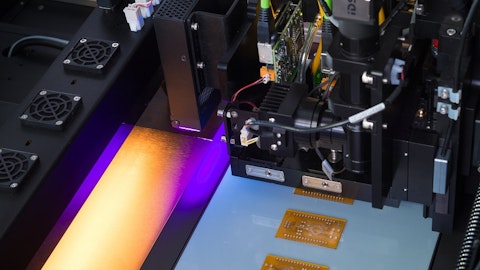Timna Tanners: Okay, thanks again. Best of luck.
David Weston: Thank you.
Operator: And our next question comes from Gautam Khanna of TD Cowen. Please go ahead. Your line is open.
Gautam Khanna: Hey, thanks. Good morning guys. And congrats, Bob and Kim.
Robert Wetherbee: Yes, thanks Gautam. It’s been a quick six years. That’s for sure, but I’m confident go and…
Gautam Khanna: Yes, it’s been click, and I was just thinking., I finally stopped calling you Rich and now you’re leading.
Robert Wetherbee: Well, obviously, you don’t call it Kim Bob.
Gautam Khanna: Exactly who knows will happen. But I wanted to just revisit what you said in your prepared remarks on 737 and destocking. And I was wondering if you could — maybe I missed it, but explicitly, has there — this has had no impact on lead times, nickel billets on your titanium airframe shipments, et cetera. Is that true like there’s just — it’s entirely — you have seen a change in schedule, but it’s been entirely offset by the other programs. Is that a fair characterization?
Robert Wetherbee: Yes. So you raised the question on two different alloy series and they have slightly different answers. So I’ll take the titanium side, and I’ll let Kim add the color on the nickel side because I think it’s important to differentiate the two. So when it comes to titanium, the 737 MAX as much as we love it, it really is much more of an aluminum-intensive vehicle as they say. And so I would say the uptick in the widebody space is more than offsetting the downside on the 737. So I would say what we see at the moment is stability in the order pattern from the guys in Seattle. So yes, a little bit down on the 37, starting to see the up on the wide-body. So the message on titanium, I think in the air structures in the United States is stable with an upward bias.
And so we haven’t seen it go down. We’ve just seen it stabilize, but we are definitely seeing interest in the second half, which is also an indication of the build rates of 2025 given the lead times of 12 to 15 months. So we are seeing that activity. It helps when A350s are going to go to 12 from 10, that will be exciting, and we are looking forward to the day when they deliver 10, 787s a month. And — so we’re starting to see that activity. So that’s kind of the titanium story. Kim, you want to fill in Gautam’s question on the nickel side.
Kimberly Fields: Sure. Yes, because that kind of leads us to the engine side and the LEAP-1-B. And as I mentioned, there has been some modifications, and we’re staying aligned with our customers. But as we look at it, it’s more of a modifying of the growth but we’re still seeing growth. And so instead of maybe 20% to 25% growth, it’s closer to like 10% to 15% growth that we’re going to continue to see from the LEAP program overall that includes that LEAP-1A and the 1C for that matter. When you look — as we look out over these different programs, as I mentioned, there are a couple of things happening. The widebody is bringing the Rolls-Royce demand forward. And so they’re looking at some of their large engines and how do they support that.
So there’s a lot of activity there. And then the GTF overhauls, obviously, they want to get through that overhaul and replacement as fast as possible. And so that’s ramping very quickly. And any capacity that we have that can go to helping them move through that program quicker is going to be used. So yes, we don’t have a lot of concern as we look at this. It’s a more slight modification of their that 1B ramp rate and everything else seems to be very robust and growing.
Gautam Khanna: And just as a follow-up, Kim, have the — what are the nickel billet lead times at this point? I think last quarter, we were thinking over 60 weeks. Is that fairly consistent?
Kimberly Fields: Yes. We do have some — there are some products that are over 70 weeks. I do think Don mentioned some of the work that we’re doing on productivity and debottlenecking. And so I’d say 12 to 15 months still, but we are working and we are seeing some capacity increases that are allowing us to pull some of those orders in and frankly, using those to react to emergent demands that our customers are having that they need to get a little bit further up in line to help them out. So we’re still in that same range. We do have some investments coming on that will help that lead time, but it’s still kind of in that 12 to 15 months.
Gautam Khanna: Thanks a lot guys.
Robert Wetherbee: Thanks, Gautam.
Operator: Thank you. We have no further questions. So I’ll turn the call back over to Dave Weston for any closing comments.
David Weston: Yes. Thanks, everyone, for your time today. Please reach out to our Investor Relations team today with any follow-up questions. And with that, thank you very much again and have a great day.
Operator: This concludes today’s call. Thank you for joining. You may now disconnect your lines.
Follow Ati Inc (NYSE:ATI)
Follow Ati Inc (NYSE:ATI)
Receive real-time insider trading and news alerts




